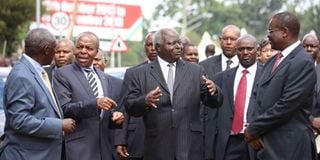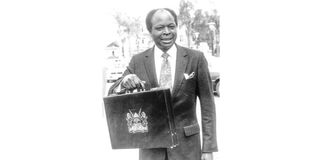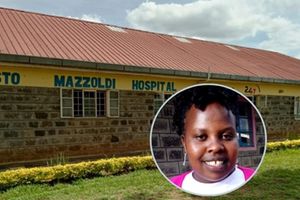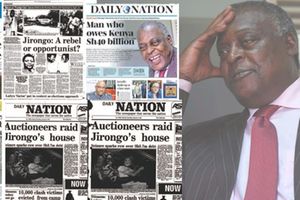Premium
Mwai Kibaki: The sharp economist who breathed life into Kenya's ailing industry

Mwai Kibaki in 2013 during the commissioning of the Nairobi Western Ring Road with then Transport Cabinet Secretary Michael Kamau (second Left), former Roads minister Franklin Bett (far left) and Nairobi Governor Evans Kidero (far right).
What you need to know:
- He slashed sky-high interest rates and rebuilt broken revenues with strong competencies at the Kenya Revenue Authority
No interaction made such a lasting impact in my career as with the departed President, Mwai Kibaki, a sharp intellectual giant. In merging academic rigour with policy insights that transform and fix broken economies, few economists cross the journey with the ease that Kibaki did.
From the start, he turned from discredited demand-side palliatives to supply-side transformations and a belief in Kenyans’ capabilities to fix their own problems and create wealth for themselves.
Ever a man of few words who stared down on political rubble-rousers (remember his exasperation with characters he called bure kabisa), we interacted twice on the journey, in two important meetings and issues. One, on his battle to unravel the economic mess that was the legacy of the Nyayo Era after 2002. Cometh a time, cometh the man who had, in the 1970s, already distinguished himself as an outstanding Finance minister.
Economic problems
President Kibaki started the turnaround by repairing a runaway banking system. He slashed sky-high interest rates and rebuilt broken revenues with strong competencies at KRA. Second, he engaged me almost casually at one time, while twirling his glass of beer at Muthaiga Country Club, when I was drafting the Kenya Country Strategy Paper CSP of 2005-2007, as a consultant for then African Development Bank. He talked of the battle to secure funding for the Thika Superhighway, which I then went on to write into the AfDB’s plan.

Kibaki with fellow students in 1957 at the London School of Economics.
First the workshop. It was hosted by IPAR in 2001, at the Norfolk Hotel. I was Director of Research at the Institute of Policy Analysis (IPAR) before returning to the AfDB as a Senior Consultant. Kibaki was a sharp listener and much, much more adept than any existing or aspiring leader today on the economic problems at hand.
He had asked for rigorous analyses on the broken public finances of a debt-ridden economy. I presented a PowerPoint of an array of options and how to find a workable policy mix between fiscal and the monetary sides.
The proposal was a sharp and innovative fiscal consolidation cutting wasteful government spending but conserving growth-inducing development spending on one hand, while slashing interest rates by taking away the feeding frenzy where banks on the liabilities side of the balance sheets teemed with customers’ deposits to merely sit back and earn high returns without a sweat. How?
They fed on the appetite of government for issuing Treasury Bills and Bonds and crowding out private sector growth.
Economic activity
A general public and private sector borrowing from banks was paying the price with astronomical interest rates and economic activity had declined to a growth rate of 0.55 per cent as of 2002. Financial intermediation was dead. While at the workshop, we listened to a long-standing Treasury official give a remix of austerity on IMF demand-side medicine without blinking. The way pupils learn by rote.
Kibaki teamed up with former Finance Minister David Mwiraria to revive the economy by taking away the banks’ punch bowl. By the time he had, in January 2003, also introduced free primary education, banks were hawking lending from kiosks on the streets, and the alternative lending to the private sector was purring the economy towards a growth rate of 8.4 per cent by 2010. The schooling initiative brought over one million children to school who would not have attended, and which today renders Kenya’s skills capacity a major plank of its development opportunities.
Altogether, development was resumed in all areas of the country, including the hitherto neglected and largely undeveloped semi-arid or arid north.
Many sectors of the economy recovered from total collapse pre-2003. A remarkable achievement was the Constituency Development Fund (CDF) introduced in 2003, designed to support constituency-level, grassroot development projects. More equitable distribution of development resources followed across regions, reducing imbalances in regional development ensuing from longstanding partisan politics.
Today, it has facilitated the putting up of new water, health, and education facilities in all parts of the country, including remote areas that were usually overlooked during funds allocation in national budgets. CDF gave birth to a devolved system of government introduced by the 2010 Constitution.
Targeted interventions
And none can gainsay the impact of the long-term blueprint, Kenya’s Vision 2030, which would have stood the country in a good chance of raising GDP growth to 10 per cent annually and transforming Kenya into a middle-income country by 2030. He also injected fiber-optics second to none on the continent and started the dream call LAPPSET. The reform of the Public Service embedded new tenets in government.
The Thika Superhighway is a different story which almost got me fired from AfDB, along with my director. We persevered with a cheeky geopolitical competition for procurement of the project, which veered East while there were keenly interested parties in the West.
Today, the economic impact of the project is a lesson on how policy and targeted interventions can trigger economic dynamism from regions, for example between Nairobi and to Nanyuki, turning dead capital to wealth. May his soul rest in eternal peace.

Mwai Kibaki.
Dr Mbui Wagacha is a former senior economic advisor, executive office of the president, and acting chairman of the Central Bank of Kenyaww.




